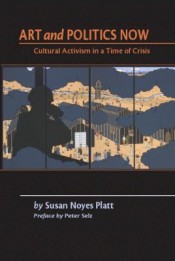For many people — artists and art consumers alike — the measure of good art is its aesthetic appeal, a measurement that comes from and is maintained by the art world. This same art establishment promotes an idea that for artists to be politically engaged is to threaten or sabotage their careers as artists. Or, artists who do use their work to comment on social issues find their work “re-positioned as an aesthetic statement,” explains activist, critic and art historian Susan Noyes Platt in her book Art and Politics Now: Cultural Activism in a Time of Crisis. In the book, Platt rejects the idea of art as purely aesthetic and, instead,
… celebrates the artists, as well as curators, who loudly cry out against immoral and illegal acts. Some of these artists have been speaking up for a long time; others have just woken up. Some are permanently engaged with political issues; other address them only once.
In the book, Platt focuses on activist artists who are using their mediums to protest or comment on war and oppression as well as artists who try to explore and defy geographical, political or aesthetic boundaries. However, Platt notes that all of the artists in the book (along with herself as the author) have shifted to the side of activism:
We are not just informed, we are outraged by the state of the world, by the actions of the U.S. government, by the devastation of war, by the oppression of the poor, and we have chosen to dedicate our creative energies to contributing to an awareness of those crimes. …
Artists who are committed to engaging contemporary political issues are convinced of the urgent necessity to use the power of art and its image-making capacity to make visible what is kept invisible; to create an alternative to the hegemonic images used by mainstream media to market “the war on terror.”
I have to admit two things before going further. First, I didn’t read all of this book. Like collections of essays, I found some chapters more engaging than others, and so I ended up skimming or skipping topics I wasn’t as interested in learning about in favor of engaging more deeply with issues that I know and care more about. I’ve come to think that, as a reader, doing some of that skimming can be ok.
Second, I’m struggling a little bit thinking about how to review this book, which is well outside the kinds of books I regularly read and write about on this blog. I’m no stranger to academic writing (although my familiarity with academic writing in arts criticism is limited), but I don’t know that it makes sense to judge academic writing by the same criteria that I think about more commercial nonfiction… and without that, I’m not entirely sure what to say. But of course I’ll give it a shot.
In general, I really enjoyed the way Platt spent time profiling artists and specific projects as she explored each of the political topics she was writing about. Her descriptions of both of the artists and their work were really engaging — in most cases, I could get a very clear picture of what the artist was doing and what one possible interpretation of the piece might be. Additionally, the book has a number of pictures at the end of each section to look at to see examples of some of the projects. I also appreciated that Platt wasn’t universally complimentary of the art she analyzed; reading about pieces or exhibitions she felt didn’t live up to their potential made it easier to understand what “successful” political art might be (at least based on one critic’s point of view).
My favorite chapter was probably one called “Women, War, and Imperialism,” which looked at, well, the intersections between contemporary feminism and militarism. I didn’t agree with many of the statements many Platt argued that the artists were trying to make, but the way she describe their artwork made me think they had some of the most specific and current statements about art to make. I also liked reading about how different feminists — which I am sometimes guilty of lumping into a homogeneous group — can have different ideas about what a feminist critique is and how to successfully talk about feminism through art.
I do wish that the book had spent some time looking at activists artists that came at their political opinions from another direction. As I think it was probably easy to infer in the quotes above, the activists profiled in the book are almost entirely artists you might call liberal or from “The Left.” (I saw almost because I may have missed some others in the chapters I skimmed… but I doubt it). While I’m sure it’s much more common to see artists protesting from that perspective, I think the book would have felt more rounded with more viewpoints represented.
If any of these topics seem of interest to you, and you aren’t afraid about picking up a book that leans towards the academic rather than the commercial, then I think Art and Politics Now could be a place to get started learning about the political role of art and artists in contemporary society.
Disclosure: I received a copy of this book for review as part of a book tour.


Comments on this entry are closed.
Thanks for your thoughtful review. I really appreciate it! The book is topical and intended to be read selectively, not all at once.